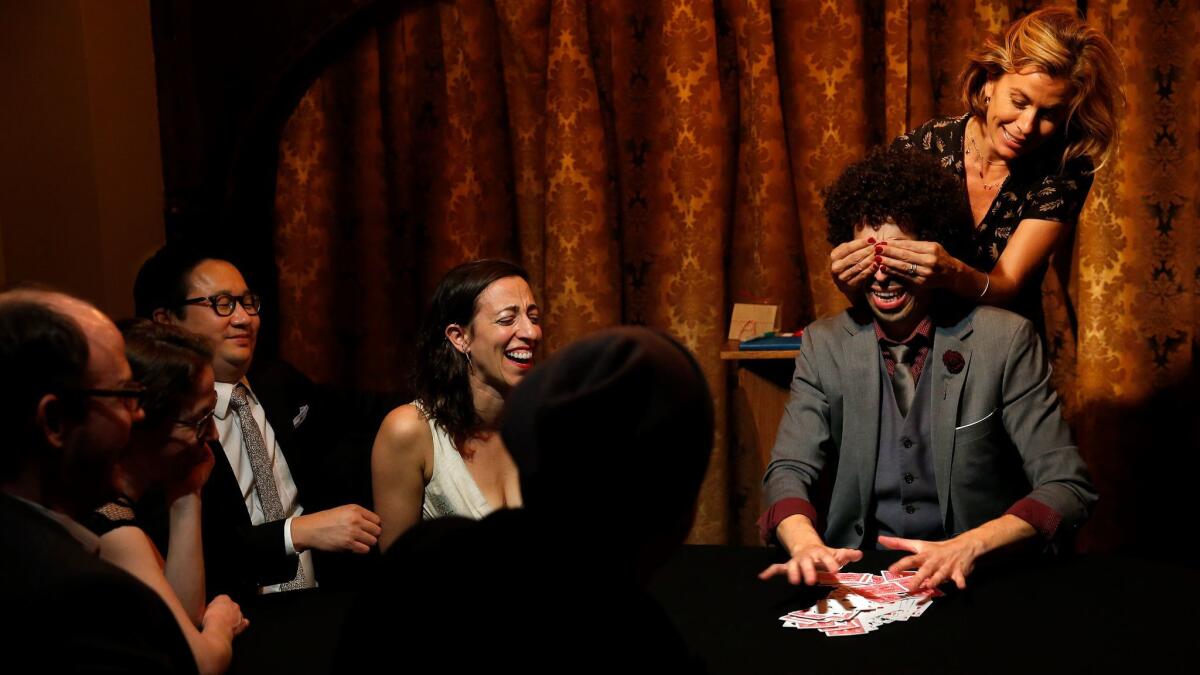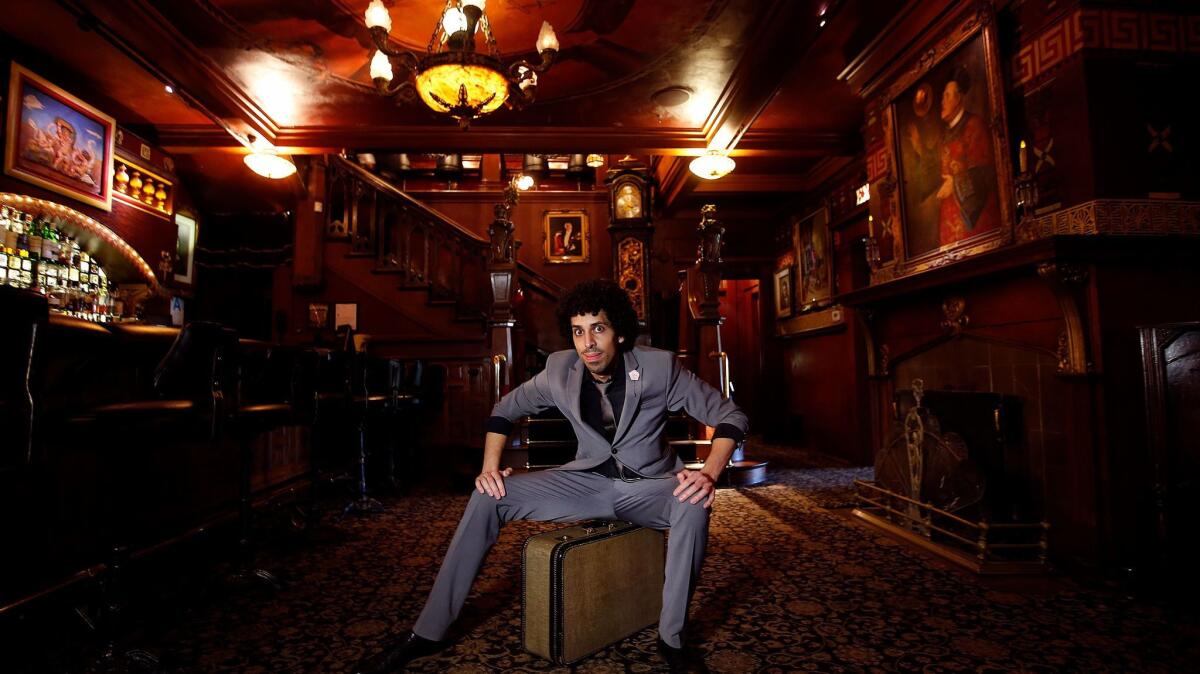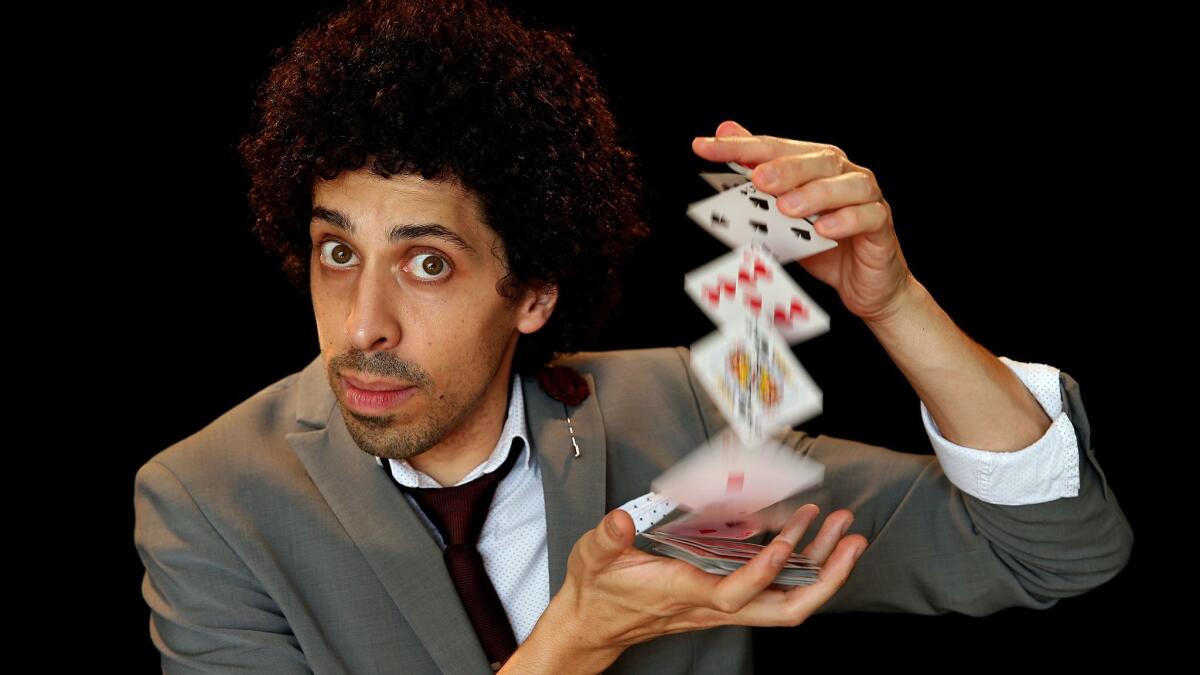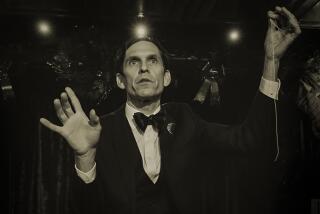He fooled Penn & Teller, now Siegfried Tieber is amazing L.A. audiences with his up-close magic show

Magician Seigfried Tieber brings his sleight of ‘handy’ work to DTLA
- Share via
Magician Siegfried Tieber is a study in contrasts.
Tall and lithe, the 30-year-old Ecuador-raised sleight-of-hand artist is dressed in the magician’s requisite formal vest and white shirt, sleeves rolled to the elbow, cheekily accented with a micro-printed floral tie, a rose pin on his lapel. At once mysterious and open, his honey-colored eyes glow with genuine affection as he literally hops out of his seat to greet guests before the show, as effusively as if each were a long-lost friend.
But after the 20 or so members of the evening’s purposely intimate audience settle into two tiers around a half moon-shaped table, Tieber starts his show wordlessly — shuffling and rearranging a deck of cards for two full minutes before addressing the crowd.
“Good evening,” he finally says, formal but friendly. “Welcome and thank you very much for joining me.”
The Los Angeles-based magician is currently closing out a limited run of live performances called “See/Saw,” presented by Atlas Obscura. Tickets have been hard to get since Tieber’s August appearance on “Penn & Teller: Fool Us,” when he stumped the famous magician duo. Wrapping on Oct. 15, Tieber’s performances take place at Civic Center Studios in downtown Los Angeles, which (fittingly) can be accessed only via a hidden entrance.
“We didn’t actually call it a secret entrance at the beginning, but people started adopting that idea,” Tieber says. “I’d like to think that having a secret entrance puts people in the mindset of entering a secret experience, something outside of the every day.”
With the combination of the speakeasy-style entry and entrancing host, not to mention the twins who announce the start of every show in unison, it’s almost guaranteed that “See/Saw” will be unlike any other performance you’ve seen.

“In these kinds of settings, what I enjoy the most is the interaction,” Tieber says. “In most performing arts, more often than not, it’s the performer on the stage, and they are communicating to you while you are mentally and emotionally engaged but listening passively. In this kind of environment, communication flows both ways. I do my 50% of the performance and the participants are doing their 50%, both of us together creating the experience.”
Tieber’s close-up form of magic, where those in the audience can have their eyes on every gesture, is enjoying a renaissance. During magic’s golden age, approximately the 1880s to the 1920s, magicians toured the world and were considered the “rock stars of the era,” as Tieber puts it. The 1970s and ’80s saw the growth of televised large-scale stage illusions or newsmaking stunts. These days, though fewer people attend shows, magic has more exposure than ever before, thanks in large part to the internet.
“Magic is not mainstream entertainment, but we definitely are in a transitional stage, with more and more people interested,” Tieber says. “Exciting things are happening.”
Tieber hadn’t always planned to be a magician. Shortly after he enrolled at Ecuador’s Universidad San Francisco de Quito to study mechanical engineering, fate dealt an auspicious hand when the then-19-year-old stumbled across a book of magic tricks.
“No clue who, how [or] why that book ended up in my hands,” he says, “but it changed my life.”
Immediately after performing for the first time for his family, Tieber became addicted to the interaction and reactions of his captive audience.
“They freaked out and I freaked out at their freaking out,” he says with a laugh.
Telling his family that he wanted to do card tricks for a living, however, was a much more somber conversation.
“My father was heartbroken, my mother was furious, I was terrified,” says Tieber, whose mom is Colombian and dad is Austrian. “I don’t blame them. After five years of university, they expected me to have a traditional career. Luckily for me … after the initial shock, they accepted it. And they have been supportive at every single step along the journey.”

From there, he started doing magic full time in his native Ecuador.
“I was doing very well financially and commercially because it’s a tiny country and there’s not much competition for magicians,” he says. “There’s ups and downs to that, of course. There’s not a lot of competition, but there’s not a lot of demand, either.”
Realizing there wasn’t much room for artistic growth, Tieber decided to move to Los Angeles in 2012, “in a nutshell, because of the Magic Castle,” the Hollywood nightclub, performing arts center and clubhouse.
“The Magic Castle is a big deal for us magicians worldwide,” he says. “It’s sort of like what Hollywood is for the film industry, pulling people from all over the world: actors, directors, writers… the same thing, on a smaller scale, of course. People who go to the Magic Castle go to watch magic and are eager and excited about it, which is half the battle won.”

Since then, he’s performed in Miami, San Francisco, Chicago and Las Vegas, as well as abroad, including Bogotá, Colombia, Calgary, Canada, and Edinburgh, Scotland, for the 2015 Fringe Festival, where he premiered “Magiko,” a one-man magic play.
“I did the whole month of the festival, and performed for maybe 29 or 30 nights in a row,” he says. “That was an exciting milestone. I learned a lot.”
Another achievement was becoming one of the rare magicians to successfully fool magicians Penn and Teller on the CW’s “Fool Us.”
“For the past five, six years of my life, Penn and Teller have been two of my heroes,” he says. “My only expectation in going in to the show was to tell them, ‘You sit there, right here, and watch really closely.’ Fooling them and whatnot was a nice added bonus. But just the experience of performing for them was absolutely amazing. I’m ridiculously proud about it.”

With the skills to fool esteemed magicians in Las Vegas (a locus for magicians and card sharks alike), it begs the question, why not see how far those conjuring skills might get you on the casino floor? But Tieber insists that he’s never considered using his talent for evil.
“Definitely not,” he says vehemently. “I think that maybe I might be able to pull it off, but it’s the same thing as [asking], ‘Have you ever considered robbing a bank or even a store?’ No, I haven’t.”
It’s clear that Tieber is in it for the love of the “misunderstood” art form rather than its potential for financial gain.
“At its very core, magic is storytelling,” he says. “Not in the traditional form of a narrative, but it’s storytelling, and it’s sharing the human experience.
“I think magic has a great potential to express complex and beautiful ideas like any other art form. And I think that magic is also very easy to fall in love with. I just wish that more people were willing and hoping and excited to experience magic. I think that they would definitely enjoy it.”
Throughout “See/Saw,” Tieber switches hats as host, historian and illusionist, explaining card-shark techniques, fielding audience questions and graciously accepting compliments (on his hands, which several of the guests coo over), all while referring to each person by name.
“What is definitely different in every single performance is the people and the interaction,” he says. “This particular event, from beginning to end, lasts about two hours. And we top the audience at 24 participants or attendees. So after spending two hours with that group of people, you actually get a sense of who each individual in this room is. There is the person who reacts more effusively, those people who are more reserved, there are those who swear when they watch a magic trick. So that definitely makes each performance different and unique.”
What’s next for Tieber after this run?
“I have no idea,” he admits. “I have many projects in mind, but we’ll see where it goes.”
follow me on twitter @sonaiyak
ALSO
Derek DelGaudio and Frank Oz creates a show beyond magic, ‘In & of Itself’
Great Read: Franz Harary, an American magician takes his tricks to China
Spoiler alert! Helder Guimarães’ ‘Borrowed Time’ magic show will leave you astonished
Review: Confessions of a magician: Derek DelGaudio reveals at least one secret to packing the house
More than magic and puppets: Derek DelGaudio and Frank Oz on their upcoming show
More to Read
Only good movies
Get the Indie Focus newsletter, Mark Olsen's weekly guide to the world of cinema.
You may occasionally receive promotional content from the Los Angeles Times.







